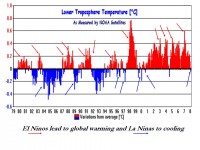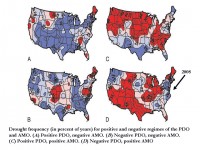Richard Sandor, president of the Chicago Climate Exchange (CCX), said in an interview with E and E TV (subscription req), “I just want to see reductions.” CCX also owns 50% of the European Climate Exchange, which covers 85% of EU emissions credits.
It dawned on me after reading this paragraph from the Wall Street Journal’s “EU greenhouse-Gas Emissions Rose 1.1% Last Year” that investment banks and hedge funds actually don’t want EU companies to reduce their emissions:
"Hedge funds, investment banks and brokers trade carbon permits as they would any other commodity, like gold or oil. And while the data released Wednesday might fuel pessimistic predictions about the effectiveness of the scheme in holding back emissions, financial players were bullish about what it meant for the carbon market."
It’s in the financial interest of hedge funds and investment banks, such as Goldman Sachs, for those emissions to keep rising. The less companies reduce emissions, the more carbon credits they need to buy. The lower the emissions cap, the harder for companies to meet the cap with actual reductions and the more money these banks and funds make through companies needing to purchase carbon credits for them.
As Sandor says about the lowering EU caps, “…lower is what we want, right?”
Henry Paulson, the current US Secretary of the Treasury and former Goldman Sachs CEO, co-founded with Al Gore, Generation Investment Management. GIM now manages $5 billion in “sustainable” investments. And Goldman Sachs owns 10% of the Chicago Climate Exchange. (See blog post entitled “Maurice Strong”)
The former vice president has been the front man on global warming – winning both an Academy Award and the Nobel Peace Prize last year in the process. The former vice president also refuses to publicly debate the issue with leading skeptics face to face.
Bullying bloggers are no strangers to online media – especially when they're Single Issue Fanatics (SIF). "They're deeply emotional, they're bullies, and they often don't get out enough," the BBC's Adam Curtis noted here last year. This week, campaigner Jo Abbess is boasting about how she browbeat the BBC into modifying a story about Global Warming. The BBC has defended the changes to its story.
Food prices, which have risen 40 percent on average since mid-2007, are causing unrest around the world. But nowhere do they pose a greater threat to democracy than in Haiti, where most people live on less than US$2 (euro1.27) a day. The protests began a week ago in the southern city of Les Cayes and escalated as protesters tried to burn down a U.N. compound and leaving five people dead.
[youtube:http://www.youtube.com/watch?v=216v5AoQcFQ 285 234]
Global temperatures for 2008 will be slightly cooler than last year as a result of the cold La Nina current in the Pacific, UN meteorologists have said.
Wheat production is down in the world’s breadbaskets, like the United States, as farmland shifts away from wheat to ethanol production. Ethanol production has increased because of government ethanol mandates and costly ethanol subsidies. In Egypt, a major wheat importer, the fall in worldwide wheat production has triggered bread shortages and unrest as poor people find it difficult to get enough to eat. The unrest is strengthening support for Islamic extremists opposed to Egypt’s relatively pro-American government.
From ICECAP.us
The BBC, UK Met Office and UN IPCC had to acknowledge that global temperatures have at least for the time being decoupled from the CO2 rise and levelled off or fallen (6-7 years). They are blaming the cooling on La Nina. They are of course correct, La Ninas global cooling just as El Ninos brings global warming. It must have pained them to do so as they have previously discussed these factors as being secondary to greenhouse gases and with impacts that were mainly regional in nature.
They promise once this event ends, their predicted warming will resume. It is likely that temperatures will bounce as the La Nina weakens but the real key as to where temperatures go over the next few years and decades is not increasing greenhouse gases but whether the multidecadal cycle in the Pacific (PDO) has transitioned back to the cold mode it was in when the earth cooled from the 1940s to the 1970s (and what happens with solar cycles 24 and 25, which many solar scientists the world over feel will revert back to the quiet modes of the so called Dalton Minimum in the early 1800s or possibly worse.)
The PDO warm phase from 1977 to 1997 was dominated by mostly El Ninos (see why here) and since they correlate with warmer global mean temperatures, it is not surprising global temperatures rose. Alarmists blamed greenhouse gases but it was likely the PDO and the Grand Maximum of the longer term solar cycles. The prior three decades had mainly La Ninas with cold temperatures like this year in more years than not and solar cycle 20 which peaked around 1970 was relatively weak and longer in length. Not surprisingly global temperatures declined.

Wolter’s Multivariate ENSO Index (MEI). Red spikes with magnitudes >0.5 are El Ninos, dips in blue with magnitudes in excess of -0.5 La Ninas. See larger graph here
Then with the Great Pacific Climate Shift in 1977, the Pacific warmed and PDO turned positive. El Ninos dominated. You can see how the El Ninos in the satellite era since 1979 have been associated with global warmth.

Note how El Ninos are invariably warm globally and La Ninas cool. Major volcanism in the early 1980s and 1990s are also seen producing cooling. See larger graph here
The PDO and the Atlantic Multidecadal Oscillation (AMO) have also been implicated in drought probabilities in an excellent paper done by Gregory J. McCabe, Michael A. Palecki, and Julio L. Betancourt in 2004. They found More than half (52%) of the spatial and temporal variance in multidecadal drought frequency over the conterminous United States is attributable to the Pacific Decadal Oscillation (PDO) and the Atlantic Multidecadal Oscillation (AMO). Recent droughts with broad impacts over the conterminous U.S. (1996, 1999-2002) were associated with North Atlantic warming (positive AMO) and northeastern and tropical Pacific cooling (negative PDO) (the bottom right map in the figure below). That is the case this summer.

Warm Atlantic (warm AMO) tend to favor drought, the PDO determines where. See larger image here
Then what of the "deniers" we have all heard about, those holdouts in the global-warming debate, complete with PhDs at the end of their names, who refuse to accept the obvious? Gore and company have a ready answer, repeated again and again: Pay no attention. These alleged scientist dissenters are either kooks or crooks who take the pay of the oil companies to spew out junk science and confuse the issue.
Global warming? Don't worry about it. It's over. No longer does Al Gore have to fly around the world in private jets emitting greenhouse gases to save the world from — greenhouse gases. The United Nations World Meteorological Organization is reporting that global temperatures have not risen since 1998.


